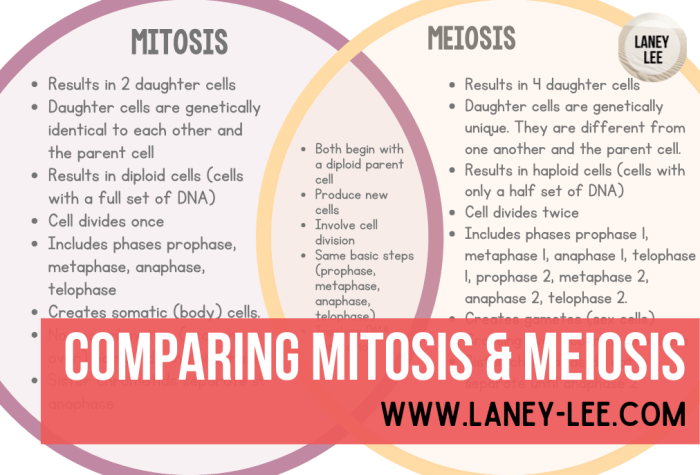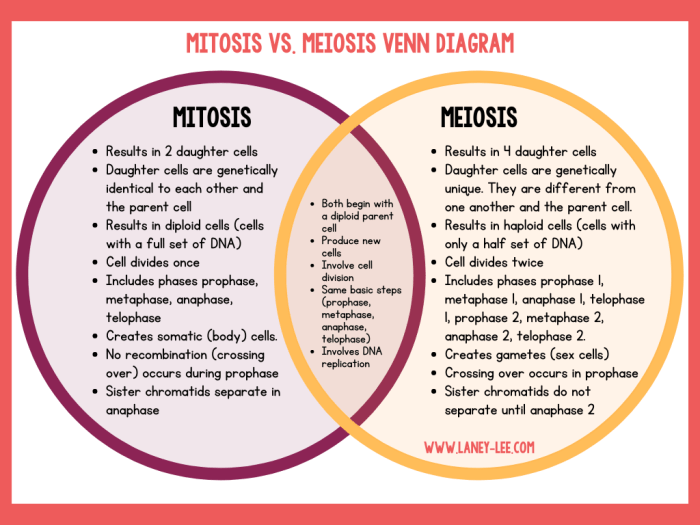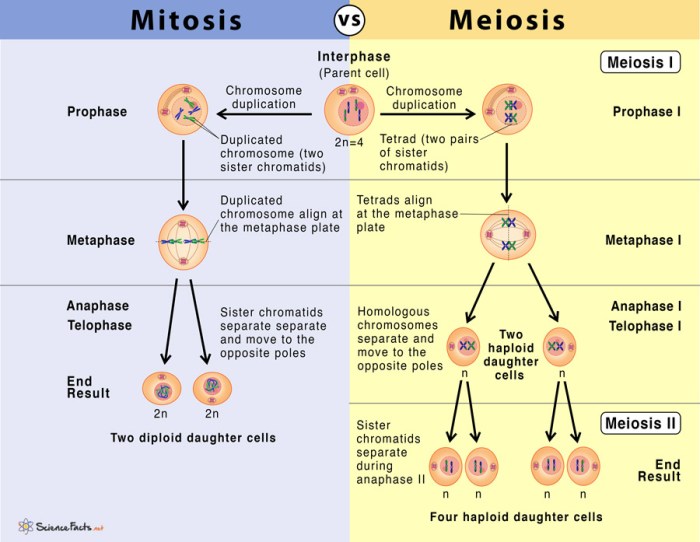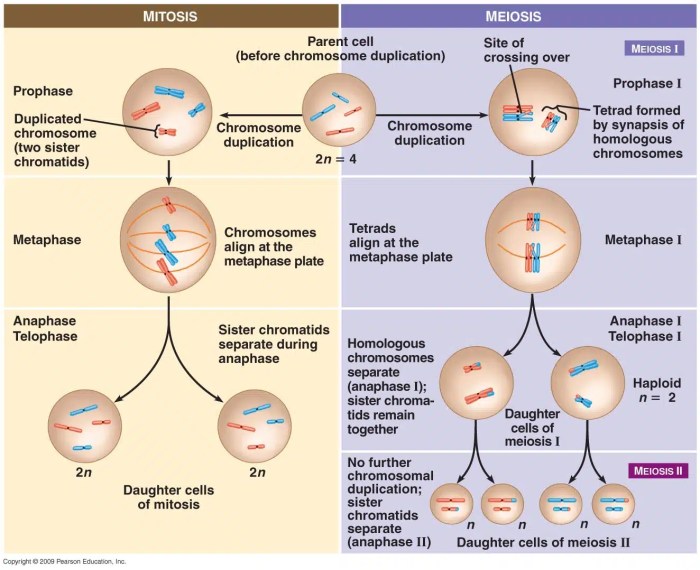In the realm of cellular biology, the processes of meiosis and mitosis hold immense significance. This meiosis and mitosis comparison chart embarks on an in-depth exploration of these fundamental processes, delving into their similarities, differences, and profound implications in shaping life.
As we delve into the intricacies of meiosis and mitosis, we will uncover the unique stages that characterize each process, unravel the contrasting behaviors of chromosomes, and decipher the genetic consequences that stem from these cellular events.
1. Introduction: Meiosis And Mitosis Comparison Chart

Meiosis and mitosis are two essential processes in the cell cycle that ensure the proper inheritance of genetic material.
Meiosis is a specialized form of cell division that occurs in reproductive cells, such as eggs and sperm, and results in the production of haploid daughter cells with half the number of chromosomes as the parent cell. Mitosis, on the other hand, is a more common type of cell division that occurs in somatic cells, such as skin cells or muscle cells, and results in the production of two genetically identical daughter cells with the same number of chromosomes as the parent cell.
The key differences between meiosis and mitosis lie in their purpose, the number of daughter cells produced, the chromosome behavior during the process, and the genetic consequences.
2. Similarities between Meiosis and Mitosis

Both meiosis and mitosis share several stages, including interphase, prophase, metaphase, anaphase, and telophase. During these stages, chromosomes undergo condensation, alignment, and separation, ensuring the accurate distribution of genetic material to daughter cells.
Additionally, both processes involve DNA replication prior to cell division, ensuring that each daughter cell receives a complete copy of the genetic material.
3. Differences between Meiosis and Mitosis

Unique Stages of Meiosis and Mitosis
Meiosis consists of two rounds of cell division, known as meiosis I and meiosis II, while mitosis consists of only one round of cell division.
During meiosis I, homologous chromosomes pair up and undergo crossing over, leading to genetic recombination and the exchange of genetic material. This process does not occur in mitosis.
Meiosis II is similar to mitosis in terms of chromosome behavior, but it results in the production of four haploid daughter cells, each with half the number of chromosomes as the parent cell. In contrast, mitosis produces two diploid daughter cells with the same number of chromosomes as the parent cell.
Differences in Chromosome Behavior, Meiosis and mitosis comparison chart
During mitosis, chromosomes line up at the metaphase plate as individual units, while in meiosis I, homologous chromosomes pair up and line up together as tetrads.
Additionally, in meiosis, chromosomes undergo crossing over, a process where genetic material is exchanged between homologous chromosomes, resulting in genetic recombination. This process does not occur in mitosis.
Differences in the Number of Daughter Cells Produced
Meiosis produces four haploid daughter cells, while mitosis produces two diploid daughter cells.
4. Consequences of Meiosis and Mitosis
Genetic Consequences of Meiosis
Meiosis plays a crucial role in sexual reproduction by ensuring genetic diversity among offspring. The process of crossing over during meiosis I leads to the recombination of genetic material, resulting in the creation of unique combinations of alleles in each daughter cell.
Additionally, the reduction in chromosome number from diploid to haploid during meiosis ensures that each gamete (egg or sperm) carries only one copy of each chromosome, preventing polyploidy in the offspring.
Role of Mitosis in Growth and Repair
Mitosis is essential for growth and development, as it allows for the production of new cells to replace old or damaged ones. It also plays a crucial role in tissue repair, enabling the body to regenerate damaged tissues and maintain homeostasis.
5. Regulation of Meiosis and Mitosis

The initiation and progression of meiosis and mitosis are tightly regulated by various factors, including cell cycle checkpoints and hormones.
Cell cycle checkpoints monitor the accuracy of each stage of the cell cycle and prevent the progression to the next stage if errors are detected. These checkpoints ensure the fidelity of chromosome segregation and prevent the propagation of genetic abnormalities.
Hormones also play a role in regulating meiosis and mitosis. For example, the luteinizing hormone (LH) triggers ovulation in females, initiating the meiotic process in the oocyte.
Key Questions Answered
What is the fundamental distinction between meiosis and mitosis?
Meiosis is a specialized form of cell division that reduces the chromosome number by half, resulting in gametes (sex cells) with a haploid set of chromosomes. In contrast, mitosis maintains the diploid chromosome number, producing two genetically identical daughter cells.
How does chromosome behavior differ during meiosis and mitosis?
In meiosis, homologous chromosomes pair up and undergo genetic recombination, leading to the exchange of genetic material. During mitosis, chromosomes condense and align along the equator of the cell, ensuring equal distribution to daughter cells.
What are the genetic consequences of meiosis?
Meiosis plays a crucial role in sexual reproduction by generating genetic diversity. The random assortment of chromosomes and genetic recombination during meiosis result in offspring with unique combinations of alleles, contributing to the genetic variation within a population.